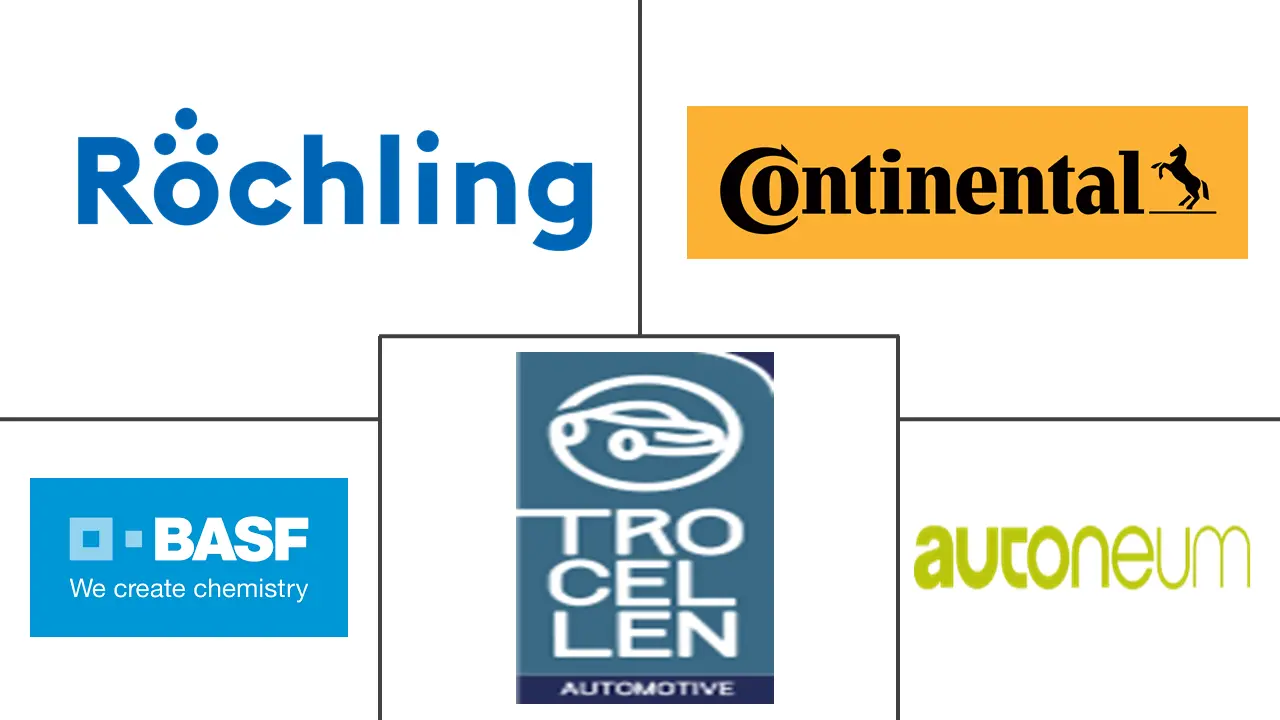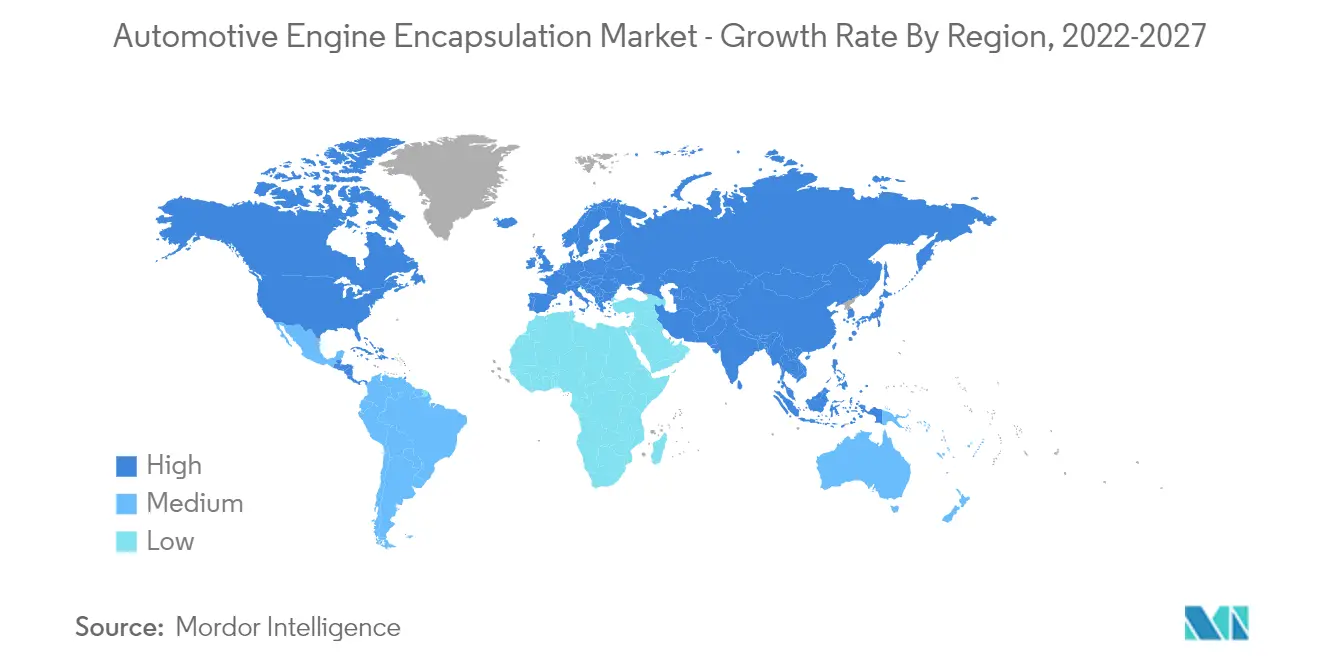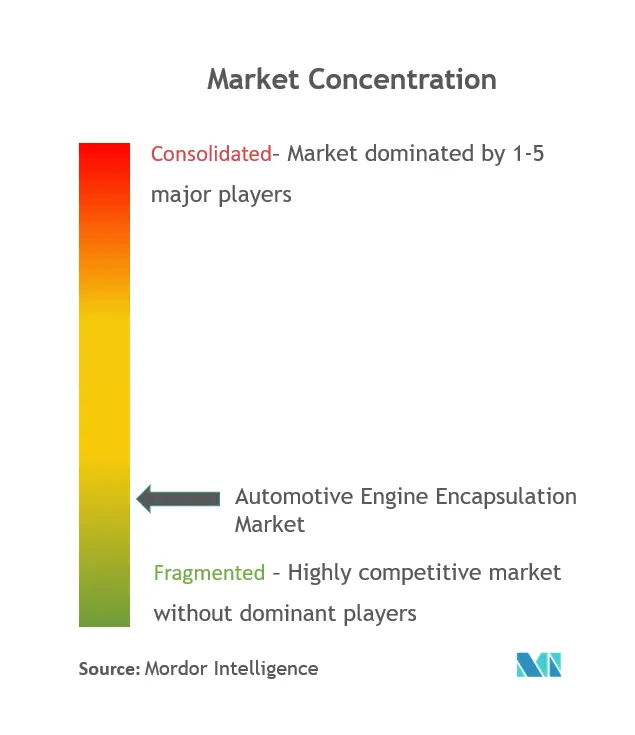Automotive Engine Encapsulation Market Size

| Study Period | 2019 - 2029 |
| Base Year For Estimation | 2023 |
| CAGR | 6.00 % |
| Fastest Growing Market | Asia-Pacific |
| Largest Market | Asia-Pacific |
| Market Concentration | Low |
Major Players
*Disclaimer: Major Players sorted in no particular order |
Automotive Engine Encapsulation Market Analysis
The automotive engine encapsulation market was valued at USD 6.2 billion in 2021 and is expected to reach USD 8.4 billion while registering a CAGR of over 6% during the forecast period 2022-2027.
The COVID-19 pandemic resulted in negative growth for the already struggling automotive sector owing to lockdowns and shutdowns, which halted the demand for vehicles for a few months in the first half of 2020. However, the market is expected to return to normalcy as economies slowly recover.
Throughout the forecast period, the key factor driving the automotive engine encapsulation market will be stringent government pollution management regulations. The importance of automobile engine encapsulation will expand as governments worldwide establish stricter pollution standards and plan to set even higher emissions restrictions over the coming years.
Due to many benefits, such as lower CO2 emissions and less airborne noise, demand for automobile engine encapsulation is predicted to rise throughout the forecast period. Engine encapsulation was formerly only available in luxury automobiles, but this feature is increasingly being offered in lower-end vehicles as well to fulfill the rigorous noise emission standards. Engine encapsulation improves vehicle fuel efficiency by allowing the engine and oils and lubricants to reach a higher beginning temperature, which is why most manufacturers include it in their cars. Due to the lack of traditional engines in electric cars, the automotive engine encapsulation market is projected to be restrained.
Automotive Engine Encapsulation Market Trends
This section covers the major market trends shaping the Automotive Engine Encapsulation Market according to our research experts:
Stringent Government Regulations to Drive Market Growth
The growing requirement for thermal management in cars operating at high speeds has been a primary driver for the automotive engine encapsulation market, which is likely to continue to grow. The increased focus of automakers and governments in several countries on improving vehicle engine efficiency has led to downsizing engines and under-the-hood vehicle parts, as well as increased research and development in this field for improved part packaging efficiency and managing engine thermals, resulting in increased demand for engine encapsulation.
Because of the high demand for efficient engines in mileage-sensitive markets in many developing countries, automakers are introducing higher pressure for combustion engines, which can also help with fuel consumption reduction, necessitating the use of high-efficiency engine thermal management systems.
The US Federal Government mandated in March 2020 that between 2021 and 2026, automotive fuel consumption and emissions be reduced by 1.5% every year. According to the US Department of Energy (DOE), lowering vehicle weight by 10% results in a 6-8% boost in fuel economy. As a result, companies have started to encapsulate engines with materials such as carbon fiber and glass fiber composites.
The automotive manufacturing industry must follow certain norms in regards to environmentally friendly recycling and dismantling of vehicles, higher fuel efficiency standards, and increased use of recyclable materials in vehicles, according to European directives and standards (2000/53/EC-End Life of Vehicles) and the US Department of Transportation, which is expected to offer high potential for composites engine encapsulations.

Asia-Pacific Dominates the Automotive Encapsulation Market
Chinese automotive exports are heavily influenced by the global economy and environmental regulations. The COVID-19 pandemic has had a marginal impact on the export of vehicles from China. For the last few years, China has been the world's largest car-producing country.
For the full year 2021, auto sales grew for the first time since 2017. Auto sales rose 3.8% from a year earlier to 26.28 million units. Chinese car brands enjoy a significant cost advantage over imported cars from international automobile manufacturers in other car markets. Thus, other developing countries and emerging markets are the main export destinations for Chinese car manufacturers.
The use of carbon fiber, which is lightweight and resistant to high temperatures, is predicted to grow rapidly in the Asia-Pacific market over the forecast period. The engine encapsulation in most sports cars and high-end automobiles is constructed of carbon fiber. China is the world's third-largest producer of carbon fiber, accounting for 12% of global output.
As most mid and premium passenger vehicles in Asia-Pacific are equipped with body mounted encapsulation, the category is expected to account for a significant portion of the automotive engine encapsulation market. As the region's middle-class population grows, so will automotive sales, and Asia-Pacific is expected to be a prominent market during the forecast period.

Automotive Engine Encapsulation Industry Overview
The automotive engine encapsulation market is fragmented, with the presence of several global and domestic players. Major players in the market include Roechling Group, Autoneum Holding AG, Trocellen Automotive, BASF SE, Continental AG, and others. The main revenue generation strategy of key players is to win contracts from OEMs. OEM expansions to cater to the demand for thermal reduction are also expected to boost the demand for engine encapsulation in the country. For instance,
In June 2021, Great Wall Motors announced plans to launch the second-generation Lemon Hybrid DHT system and a dedicated hybrid engine with a thermal efficiency level of more than 45% in 2023.
Automotive Engine Encapsulation Market Leaders
-
Trocellen Automotive
-
Autoneum Holding AG
-
BASF SE
-
Continental AG
-
Roechling group
*Disclaimer: Major Players sorted in no particular order

Automotive Engine Encapsulation Market News
In October 2021, Continental announced supply contracts for engine mounts for several vehicle manufacturers in Europe, the US, and China and showcased its capability to supply tailor-made solutions via collaborations with OEMs.
In February 2021, BASF announced that it is expanding its product portfolio of polyamides for the high-temperature range by developing new heat-stabilized Ultramid® B3PG6 BK23238 for the high-temperature range. The polyamide, reinforced with 30% glass fibers, is known to exhibit an excellent thermal aging performance and vibration in internal combustion engines, hybrids, or electric vehicles (EV).
Automotive Engine Encapsulation Market Report - Table of Contents
1. INTRODUCTION
- 1.1 Study Assumptions
- 1.2 Scope of the Study
2. RESEARCH METHODOLOGY
3. EXECUTIVE SUMMARY
4. MARKET DYNAMICS
- 4.1 Market Drivers
- 4.2 Market Restraints
-
4.3 Porter's Five Force Analysis
- 4.3.1 Threat of New Entrants
- 4.3.2 Bargaining Power of Buyers/Consumers
- 4.3.3 Bargaining Power of Suppliers
- 4.3.4 Threat of Substitute Products
- 4.3.5 Intensity of Competitive Rivalry
5. MARKET SEGMENTATION
-
5.1 Product Type
- 5.1.1 Engine Mounted
- 5.1.2 Body Mounted
-
5.2 By Fuel Type
- 5.2.1 Gasoline
- 5.2.2 Diesel
-
5.3 By Material Type
- 5.3.1 Carbon Fiber
- 5.3.2 Polyurethane
- 5.3.3 Polypropylene
- 5.3.4 Polyamide
- 5.3.5 Glasswool
-
5.4 Geography
- 5.4.1 North America
- 5.4.1.1 US
- 5.4.1.2 Canada
- 5.4.1.3 Rest of North America
- 5.4.2 Europe
- 5.4.2.1 Germany
- 5.4.2.2 UK
- 5.4.2.3 France
- 5.4.2.4 Italy
- 5.4.2.5 Rest of Europe
- 5.4.3 Asia-Pacific
- 5.4.3.1 India
- 5.4.3.2 China
- 5.4.3.3 Japan
- 5.4.3.4 South Korea
- 5.4.3.5 Rest of Asia-Pacific
- 5.4.4 Rest of the World
- 5.4.4.1 Latin America
- 5.4.4.2 Middle-East and Africa
6. COMPETITIVE LANDSCAPE
- 6.1 Vendor Market Share
-
6.2 Company Profiles
- 6.2.1 Continental AG
- 6.2.2 Furukawa Electric Co. Ltd
- 6.2.3 SA Automotive
- 6.2.4 BASF SE
- 6.2.5 3M
- 6.2.6 Evonik Industries AG
- 6.2.7 Compagnie de Saint-Gobain SA
- 6.2.8 Erlingklinger AG
- 6.2.9 Autoneum Holding AG
- 6.2.10 Adler Pelzer
- 6.2.11 Trocellen Automotive
- 6.2.12 Roechling Group
- 6.2.13 Woco Group
- 6.2.14 Charlotte Baur Formschaumtechnik GmbH
- *List Not Exhaustive
7. MARKET OPPORTUNITIES AND FUTURE TRENDS
** Subject To AvailablityAutomotive Engine Encapsulation Industry Segmentation
Automotive engine encapsulation keeps the engine's heat within the engine compartment and improves the efficiency and performance of the vehicle engine by allowing oils and lubricants to work optimally. Furthermore, it reduces vehicle-generated noise by using a material with an acoustic function of up to 5 dB. This market is predicted to grow throughout the forecast period due to rising luxury car sales, growing income levels, and increasing customer awareness.
The automotive engine encapsulation market is segmented by product type, fuel type, material type, and geography.
Based on product type, the market is segmented into engine mounted and body mounted.
By fuel type, the market is segmented into gasoline and diesel.
By material type, the market is segmented into carbon fiber, polyurethane, polypropylene, polyamide, and glasswool.
By geography, the market is segmented into North America, Europe, Asia-Pacific, and Rest of the World.
| Product Type | Engine Mounted | |
| Body Mounted | ||
| By Fuel Type | Gasoline | |
| Diesel | ||
| By Material Type | Carbon Fiber | |
| Polyurethane | ||
| Polypropylene | ||
| Polyamide | ||
| Glasswool | ||
| Geography | North America | US |
| Canada | ||
| Rest of North America | ||
| Geography | Europe | Germany |
| UK | ||
| France | ||
| Italy | ||
| Rest of Europe | ||
| Geography | Asia-Pacific | India |
| China | ||
| Japan | ||
| South Korea | ||
| Rest of Asia-Pacific | ||
| Geography | Rest of the World | Latin America |
| Middle-East and Africa |
Automotive Engine Encapsulation Market Research FAQs
What is the current Automotive Engine Encapsulation Market size?
The Automotive Engine Encapsulation Market is projected to register a CAGR of greater than 6% during the forecast period (2024-2029)
Who are the key players in Automotive Engine Encapsulation Market?
Trocellen Automotive, Autoneum Holding AG, BASF SE, Continental AG and Roechling group are the major companies operating in the Automotive Engine Encapsulation Market.
Which is the fastest growing region in Automotive Engine Encapsulation Market?
Asia-Pacific is estimated to grow at the highest CAGR over the forecast period (2024-2029).
Which region has the biggest share in Automotive Engine Encapsulation Market?
In 2024, the Asia-Pacific accounts for the largest market share in Automotive Engine Encapsulation Market.
What years does this Automotive Engine Encapsulation Market cover?
The report covers the Automotive Engine Encapsulation Market historical market size for years: 2019, 2020, 2021, 2022 and 2023. The report also forecasts the Automotive Engine Encapsulation Market size for years: 2024, 2025, 2026, 2027, 2028 and 2029.
Automotive Engine Encapsulation Industry Report
Statistics for the 2024 Automotive Engine Encapsulation market share, size and revenue growth rate, created by Mordor Intelligence™ Industry Reports. Automotive Engine Encapsulation analysis includes a market forecast outlook to 2029 and historical overview. Get a sample of this industry analysis as a free report PDF download.



